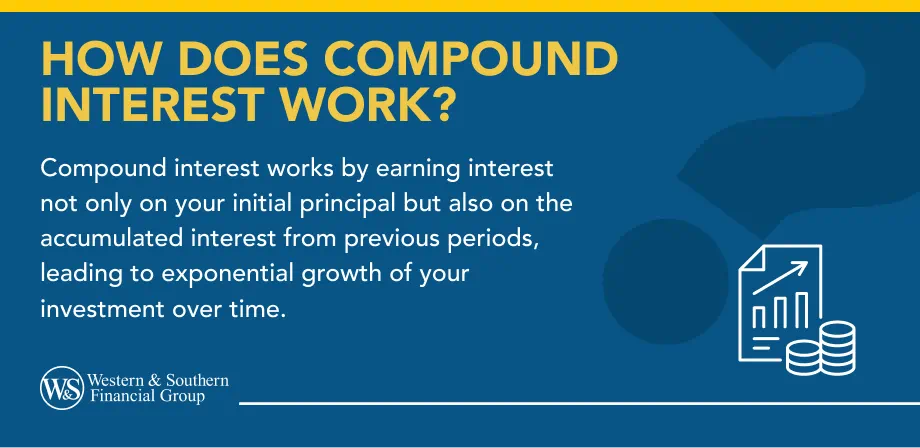

Table of Contents
- What Is Compound Interest?
- How to Calculate Compound Interest
- Applying the Compound Interest Formula
- Compound Interest Example
- How to Earn Compound Interest
- Understanding Annual Percentage Yield (APY)
- How Can You Make the Most of Compound Interest?
- Example of Why it Pays to Start Saving Early
- The Bottom Line
Key Takeaways
- Compound interest allows you to earn interest on both the principal amount and the accumulated interest over time, resulting in exponential growth.
- The frequency of compounding affects the interest earned, with more frequent compounding increasing overall interest.
- Starting early maximizes the benefits of compound interest due to the longer compounding period.
- Various financial products offer compound interest opportunities, such as savings accounts, CDs, money market accounts, bonds, and dividend reinvestment plans.
- Understanding the Annual Percentage Yield (APY) helps compare returns of different products, as it includes both the interest rate and compounding frequency.
To help you better understand compound interest, here's some information on what it is, how to calculate it, and how it can help boost your retirement savings.
What Is Compound Interest?
Compound interest is when you earn money on the original amount you put in and also on the interest you've already earned. It's like making "extra" interest, growing your money faster over time. But if it's for a loan, you'd owe more money because the interest also grows.
When calculating compound interest, the interest rate is multiplied by your principal balance plus the amount of interest that's already accrued in your account. For that reason, compound interest is sometimes referred to as earning "interest on interest."
Say, for example, that a customer has $10,000 in a retirement savings account and the financial institution offers a 2% interest rate. If the financial institution compounds interest once a year, the account would accrue $200 in the first year ($10,000 x 0.02). But in the second year, you would receive an interest credit of $204. That's because the financial institution is multiplying its 2% rate by $10,200, which is the amount of the initial deposit plus the previous year's interest.
The extra $4 generated by using compound interest may not sound like much of a difference. But the key to compounding is that the effect becomes larger over time.
Assuming the customer above does not make any additional deposits or withdrawals, that same account would be worth $12,190 in 10 years if the interest is compounded yearly. And by year 20, its value would jump to $14,859.
How to Calculate Compound Interest
The amount of interest built up through the compounding method is a function of the interest rate, the frequency with which the financial institution compounds the interest, and the length of time the money is left in an interest-bearing account. The compound interest formula is:
A = P(1+r/n)nt
In the above formula:
- A = ending balance
- P = principal amount
- r = nominal (stated) interest rate
- n = number of times interest is compounded per year
- t = number of years money is left in account
Applying the Compound Interest Formula
Let's apply this formula to the example mentioned earlier, supposing that the customer left a $10,000 principal balance in their savings account. "R" is 0.02, which represents the 2% annual rate. If interest only compounds once a year, we'd divide that rate by 1, which represents the once-a-year compounding method. To determine the account balance after 10 years, we'd multiply 1 (our compounding frequency) by 10. The result is an ending balance of $12,190.
One of the important aspects of this formula is that "n" — the number of compounding periods in a given year — is part of the exponent. As a result, the more frequently a financial institution performs compounding, the greater the amount of interest you'll earn from the very same stated interest rate.
To show why this matters, let's take the same numbers from the earlier example but assume the institution uses a daily compounding method. This means that the existing balance multiplies every day — including any accrued interest — by the annual interest rate divided by 365. If the annual interest rate is 2%, the daily rate would be 0.00005479.
Because of the more frequent compounding interval, the customer is able to build a slightly higher balance from the same initial balance. Of course, the greater the amount that you deposit, the greater the dollar amount difference will be from compounding. So, while the extra earnings may seem small on a $10,000 opening balance, the difference on, say, a $100,000 account would be significantly greater.
Compound Interest Example
Let's imagine you put $5,000 into an account with compounding interest that has a 6 percent return — and you let the money sit there for 25 years. Without putting anything else into the account, you could have just under $22,000 at the end of that period because the return is calculated using both the amount of the original investment and accumulated interest.
The compounding effect is primarily about time, but another critical driver is the interest rate, or investment growth rate, on your savings. The higher the rate of return, the bigger the potential compounding advantage. That's compounding interest in a nutshell.
Now, suppose you put that same $5,000 into an account with simple interest instead. With simple interest, you would only receive interest on your original investment every year. In this example, $300 (6 percent of the initial $5,000 contribution) would be added to the value of your investment annually. At the end of that 25-year period, you could wind up with $7,500 in total interest added to your original $5,000 investment, giving you a total of $12,500 — a lot less than $22,000!
Now, let's imagine you saved $500 every month, or $6,000 a year, starting at age 25. Assuming a 6 percent annual rate of return, 40 years later you could wind up with nearly $1 million using compounding interest. (And if you saved twice as much every year, your accumulations could also be double at each stage.)
For these examples, we're not taking taxes and wild swings in the annual rate of return on your savings into account. The point is not to predict investment returns, but to show the potential impact of compounding interest on your savings.
Try running your own numbers using our compound interest calculator .
How to Earn Compound Interest
You can earn compound interest by putting your money into various kinds of savings and investment vehicles, such as the following:
- Savings accounts – Regular savings accounts at financial institutions like banks, credit unions and savings and loan institutions generally include compounding interest.
- Certificates of deposit (CDs) – Because you agree to leave your money in CDs for a specified period of time, they generally offer you a higher rate of return than savings accounts and often compound interest on a daily basis, which means a higher effective rate of return. While daily compounding can boost the value of your CD upon maturity, there are usually penalties for early withdrawals, so your money may be inaccessible for longer periods of time.
- Money market accounts – Interest earned on money market accounts is usually compounded daily and deposited monthly. You can take advantage of this compounding by letting your deposits of interest remain in your account to continue to earn additional interest. Money markets generally offer you a higher rate of interest than regular savings accounts
- Zero-coupon bonds – With a traditional bond, you often receive periodic interest payments in the form of coupons that don’t compound. However, zero-coupon bonds are fixed-income securities that are offered at a deep discount of their original face value. When you invest in a zero-coupon bond, they grow gradually through compounding until you receive principal and interest when it reaches maturity. Like other types of bonds, zero coupon bonds are subject to interest-rate risk if you sell before maturity. If interest rates rise, the value of your zero coupon bond on the secondary market will likely fall. These investments may not keep pace with inflation and default risk should be considered when researching and investing in corporate or municipal zero coupon bonds.
- Stock & mutual fund reinvestments – When you reinvest earnings received from stocks and mutual funds, you can take advantage of compounding. Dividend reinvestment plans allow you to buy additional shares of stocks and mutual funds. By choosing to continually reinvest, you can transform your brokerage account into a compounding one. Keep in mind that all investments come with risk, including the potential for loss of the principal amount invested. Dividends are not guaranteed.
Understanding Annual Percentage Yield (APY)
Though it's useful to understand how compounding works, the reality is that you don't necessarily need to perform any complicated math to compare the returns offered by different products. That's because financial institutions will typically publish something called the "annual percentage yield" or APY.
The Annual Percentage Yield (APY) can tell you how much the account will yield based on how often the interest is compounded.
So, you don't need to know what interest rate is used to calculate your interest or how often it accrues interest; the APY typically factors all that in.
How Can You Make the Most of Compound Interest?
When trying to save money, compound interest can be significant. Because interest accrues exponentially when it is compounded, the amount credited to one's account can get bigger over time. While the effect may be small in the first year or two, the interest in an account with compound interest would start to "accelerate" after 10, 20 or 30 years. Therefore, people who save early could reap the biggest benefits of compounding interest.
Example of Why it Pays to Start Saving Early
Let's look at another example. Say that a 50-year-old woman opens a savings account that pays a 2% annual rate. If she contributes $100 a month, she'll end up with $13,272 by the time she's 60 years old (assuming interest is compounded monthly and no withdrawals have been made).
But if she had started at age 30, she would have $49,273 in the account by age 60. Because the interest earned in the first few years continues to accrue additional interest, the amount she deposited in her 30s represents a bigger share of her ending balance than the amount she contributed in recent years.
The Bottom Line
When it comes to saving for retirement and managing your finances, understanding compound interest may help you make strategic financial decisions. For more information on how compound interest can impact your retirement savings, consider speaking with a financial representative.















